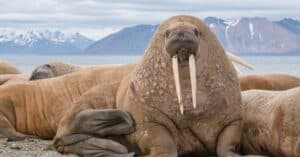When we think of big mammals, our minds might first jump to the blue whale or the elephant. While these warm-blooded giants top the list of biggest mammals, the walrus isn’t too far behind them in size.
Walruses are large, blubbery animals with rounded heads, no external ears, and impressive quill-like mustaches. Part of the pinniped group, they have flat flippers and wrinkly brown and pink skin. These bulky animals look awkward on land, but they are much more graceful once they hit the water.
Part of a walrus’s bulk is due to its thick layer of blubber. Having a healthy amount of blubber insulates the walrus from the cold ocean temperatures. It also provides energy reserves that the walrus can draw on when food is scarce. They may look fat, but every pound has a purpose.
Walrus size is especially impressive considering they maintain that mass on a diet of mollusks, crustaceans, and worms. They prefer clams, but will also eat crabs, sea cucumbers, snails, or sometimes even fish. Walruses suck food into their mouths using suction created by pulling their tongues back very quickly, allowing them to slurp food off the bottom of the ocean with ease. They can eat up to 80-100 pounds of food a day, generally spread out over two meals. Consuming this many calories allows them to keep their body fat levels and blubber reserves high.
Different Types and Sizes of Walruses
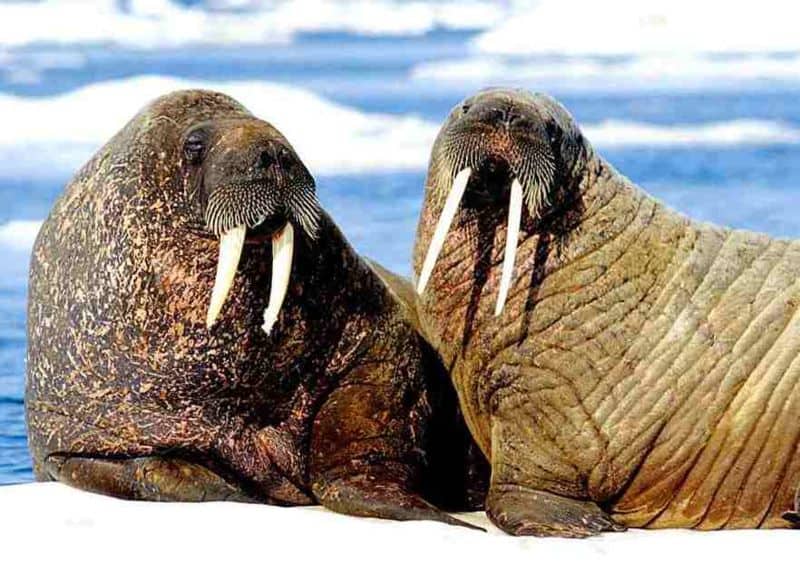
Walrus tusks are made of ivory, though it is different than the ivory of
elephant
tusks.
©Ansgar Walk / CC BY-SA 3.0 – License
With all that blubber, it comes as no surprise that walruses live in arctic climates. There are two subspecies of walrus that can be found in the chilly waters of the Atlantic and Pacific oceans respectively. These big animals are the third-largest pinniped species in the world, after the two types of elephant seals.
Atlantic Walruses
The Atlantic walrus (Odobenus rosmarus rosmarus) lives in the cold waters and shores of Greenland, Norway, Canada, and Russia. While these walruses used to be found in Nova Scotia, St. Lawrence, and Newfoundland, excessive hunting between the 17th and 19th centuries wiped them out in these areas. Even in their remaining territory, there are only around 21,400 Atlantic walruses in the world.
Atlantic walruses are smaller than their Pacific counterparts, and they have smaller tusks. Males average around 2,000 pounds, with females weighing 880-1,230 pounds. The males are typically 9-10 feet long, while females are around 8 feet.
Pacific Walruses
On the other side of North America, Pacific walruses (Odobenus rosmarus divergens) can be found in the Northern Pacific between Alaska in Russia, in and around the Bering Sea and Chukchi Sea. The Pacific population is higher than the Atlantic, with an estimated population of around 200,000.
The Pacific walrus can reach massive proportions. They are 10-20% larger than the Atlantic walrus on average. Males can reach as much as 4,400 pounds, though most weigh between 1,800 and 3,700 pounds. Females weigh around two-thirds as much as males, and average around 1,800 pounds. Males can be up to 12 feet long, while females still reach an impressive length of 7.5-10 feet.
How Big Are Walruses When They Are Born?
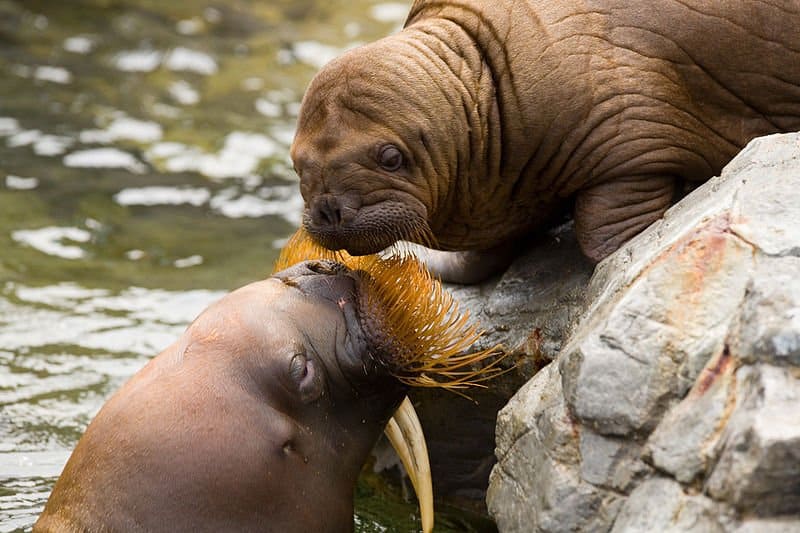
Walruses can swim at birth, but calves stay with their mother for the first three years.
©Max Smith / CC0 – License
A baby walrus is tiny in comparison to an adult, but they are not small infants! With a 15-month-long gestation period, walruses have plenty of time to grow. Newborn walruses of both subspecies and sexes weigh from 73 to 187 pounds at birth, and they are 3-4 feet long. In comparison, the average full-term human baby weighs just 7 pounds and measures a mere 20 inches when they are born.
The Largest Walrus Ever Recorded
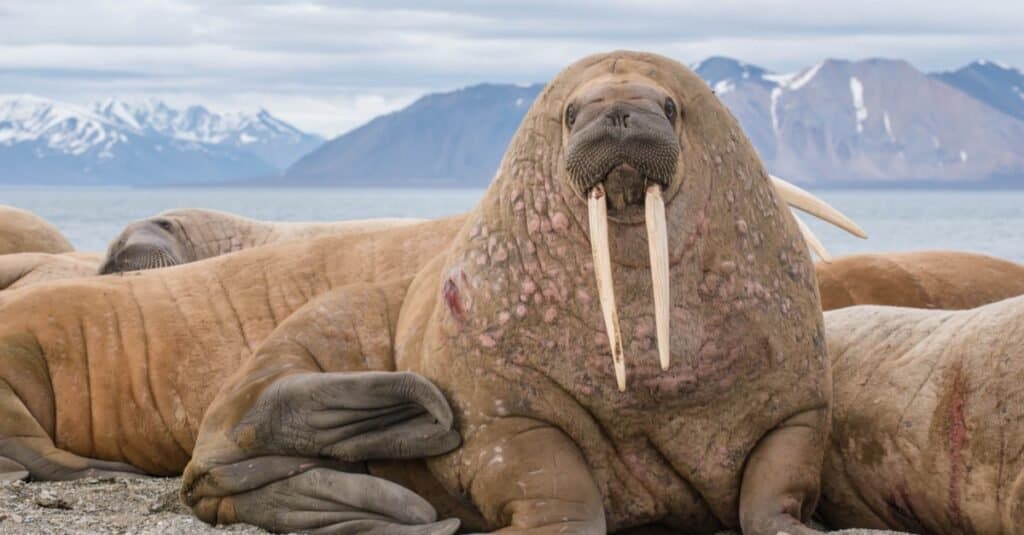
Walrus blubber can be up to 3.9 inches thick, and make up a third of a walrus’s body weight in winter.
©Mikhail Cheremkin/Shutterstock.com
It is nearly impossible to get a weight on a wild walrus, so the largest walrus ever recorded has to be extrapolated from the weight of their hides. A walrus’s hide makes up for around 20% of its body weight. In 1909, the hide of an enormous Pacific walrus was found — weighing 1,100 pounds! The next year, a 16-foot walrus was shot and skinned, with a hide weighing 1,000 pounds. Assuming the hides did in fact make up a fifth of the animals’ body weights, each walrus weighed at least 5,000 pounds.
Tusks also come supersized! In 1997, Ralph Young found the remains of a walrus on the shores of Bristol Bay in Alaska. The walrus’s tusks measured over 3 feet long and were almost 10 inches in circumference at the base, setting a world record that scored 147-4/8 points.
How Does Walrus Size Compare?
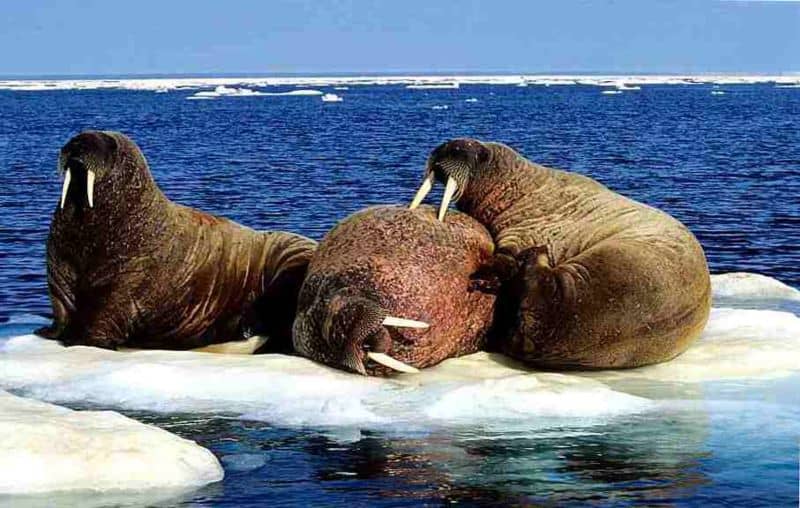
If an average adult human male were to lie next to a walrus, the walrus would be about twice as long as the man.
©Ansgar Walk / CC BY-SA 3.0 – License
In a battle of mass between human and walrus, money shouldn’t go on the human. Walruses are around 19 times heavier than people. The average male human in the United States weighs around 198 pounds, while the average male walrus in Alaska is between 1,800 and 3,700 pounds. This is approximately the same weight as a four-door sedan or small SUV. It’s also around the same heaviness as a hot tub filled with water or a dumpster!
Are Walruses Bigger Than Elephant Seals?

While walruses are bigger than most species of pinnipeds, the elephant seal isn’t one of them. Like walruses, elephant seals have two subspecies, the northern elephant seal (Mirounga angustirostris) and the southern elephant seal (Mirounga leonina). Although walruses can reach an impressive 12 feet long and 4,000 pounds, elephant seals average 10-16 feet, and weigh up to 7,000 pounds.
Some southern elephant seal bulls can measure up to 20 feet long and weigh 9,000 pounds. The record-holding largest elephant seal was caught in 1913, and measured 22.5 feet long. There aren’t very many animals that can rival that size! In fact, the elephant seal is the sixth-heaviest mammal in the world.
The photo featured at the top of this post is © Inge Jansen/Shutterstock.com
Thank you for reading! Have some feedback for us? Contact the AZ Animals editorial team.




